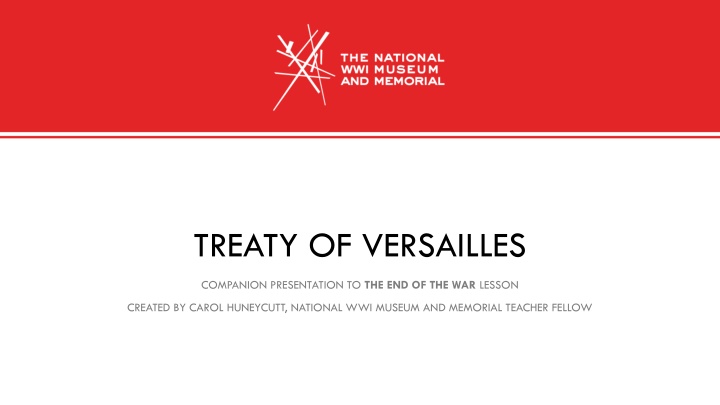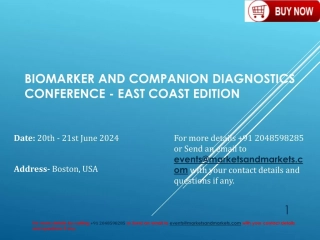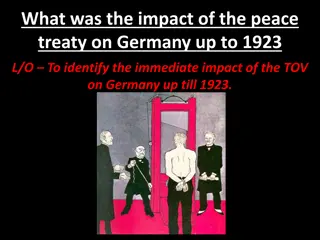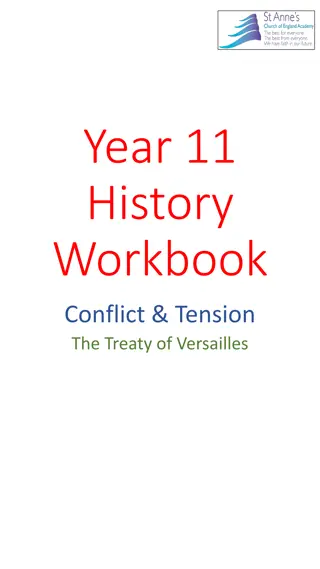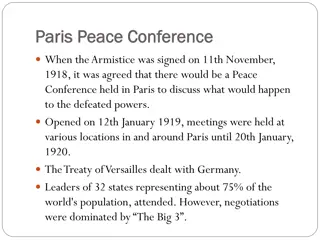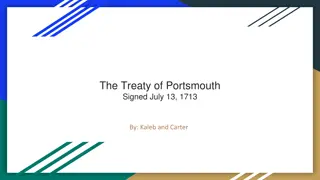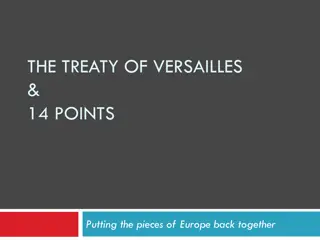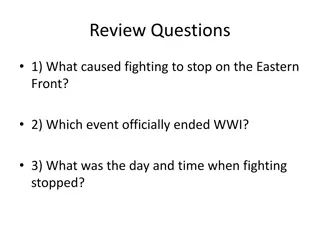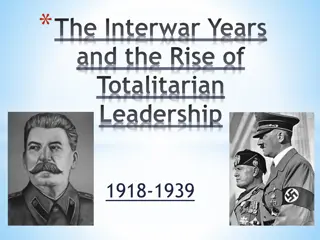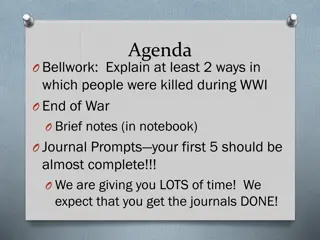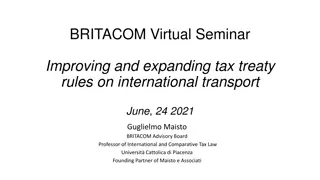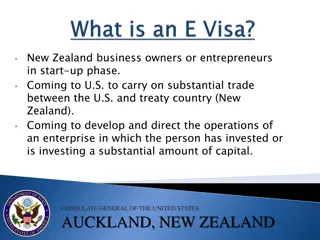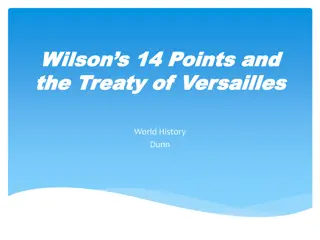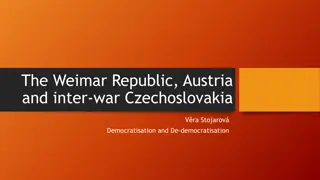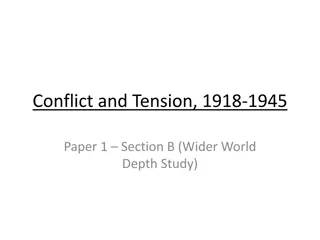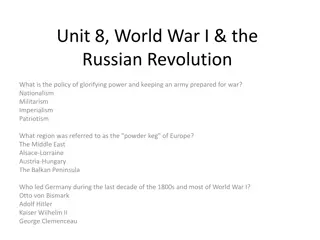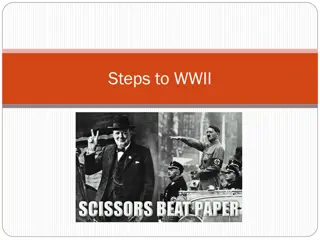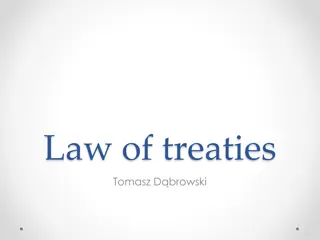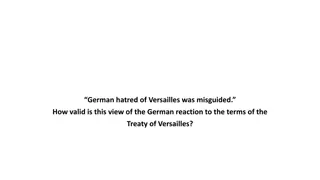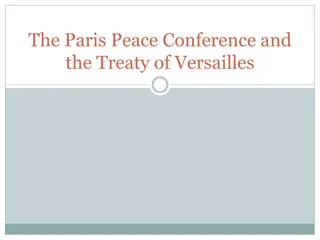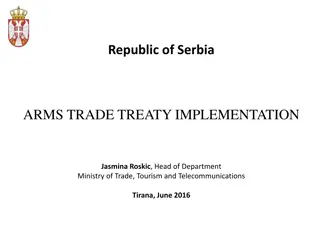Treaty of Versailles Companion Presentation: Understanding the End of WWI
Explore the Treaty of Versailles and its significance through a companion presentation covering the Paris Peace Conference, major players like the Big 3, negotiation roles, and key terms. Learn about the attitudes of France, Great Britain, and the United States towards Germany post-WWI, the terms of the treaty, and debates on its fairness. Dive into historical context with visuals, objectives, and a video clip depicting the end of World War I.
Download Presentation

Please find below an Image/Link to download the presentation.
The content on the website is provided AS IS for your information and personal use only. It may not be sold, licensed, or shared on other websites without obtaining consent from the author.If you encounter any issues during the download, it is possible that the publisher has removed the file from their server.
You are allowed to download the files provided on this website for personal or commercial use, subject to the condition that they are used lawfully. All files are the property of their respective owners.
The content on the website is provided AS IS for your information and personal use only. It may not be sold, licensed, or shared on other websites without obtaining consent from the author.
E N D
Presentation Transcript
TREATY OF VERSAILLES COMPANION PRESENTATION TO THE END OF THE WAR LESSON CREATED BY CAROL HUNEYCUTT, NATIONAL WWI MUSEUM AND MEMORIAL TEACHER FELLOW
LESSON OBJECTIVES To understand the attitudes of the France, Great Britain and the United States towards Germany at the end of WWI To explain the terms of the Treaty of Versailles To evaluate whether or not the Treaty of Versailles was fair
KEY WORDS Armistice = an end to fighting Treaty = a formal written agreement between two or more states Reparation = pay for damage caused Re-conquer = get back Vengeance = revenge
VIDEO CLIP This Day in History, November 11, 1918: World War I Ends, ABMC Videos https://youtu.be/_UTUr_Htnaw
PARIS PEACE CONFERENCE When the Armistice was signed on November 11, 1918, it was agreed that there would be a Peace Conference held in Paris to discuss what would happen to the defeated powers. Opened on January 12, 1919, meetings were held at various locations in and around Paris until January 20, 1919. The Treaty of Versailles dealt with Germany. Leaders of 32 states representing about 75% of the world s population attended. However, negotiations were dominated by the Big 3.
MAJOR PLAYERS THE BIG 3 Georges Clemenceau, France Woodrow Wilson, United States David Lloyd George, Great Britain
JANUARY 1919, VERSAILLES PALACE Your table should include four students. Each student will have one of the following roles: Representing Great Britain Prime Minister, David Lloyd George Representing France President, Georges Clemenceau Representing the United States of America President, Woodrow Wilson Representing Germany a German representative
NEGOTIATING THE TREATY You will be given a headband as a representative of one of the countries at the Paris Peace Conference. Move and sit with others with your same role. Your first task is to research your role at the conference using the documents provided and internet access. Discuss with the other representatives from your country what you want from the treaty. You will only have a few minutes and you need to come up with 3-5 bullet points of what you want!
NEGOTIATING THE TREATY Return to your places and your original group. Now that you have decided on what your country wants, you need to negotiate in order to get it. There are 6 key areas in which you will need to decide what happens. Remember you will have to compromise on some things to get other things that you want. All of the 3 negotiators need to agree on the Treaty before they sign it. The German representatives can observe, and must sign, but cannot participate.
HOW DID YOU DO? We are going to compare your treaty with the real Treaty of Versailles.
VIDEO CLIPS Part 2 Part 1 The Treaty of Versailles - What did the Big Three Want?, Simple History https://youtu.be/vrYhLNQMRro and https://youtu.be/0jycVFL8CNM
THE TREATY OF VERSAILLES Harsh Germany was forced to accept full blame for the war See the War Guilt Clause, Article 231 Independence from Austria Germany is banned from forming a union with Austria Take away military Germany s army reduced to 100,000 men, no submarines, no airplanes, 36 ships (6 battleships) Land Germany lost Alsace-Lorraine to France; kept the Rhineland but had to stay demilitarized Established the League of Nations Reparations - $33 billion
ILLUSTRATED TREATY Create 6 equally sized squares on your paper. Design an illustration for each portion of the Treaty of Versailles that shows your understanding of each treaty component (Harsh treatment, Independence from Austria, Military reduction, Land, League of Nations, Reparations)
EVALUATION Do you think the Treaty of Versailles was fair? Explain why you think this. Were there portions of the treaty that were more fair (or less fair) than others?
